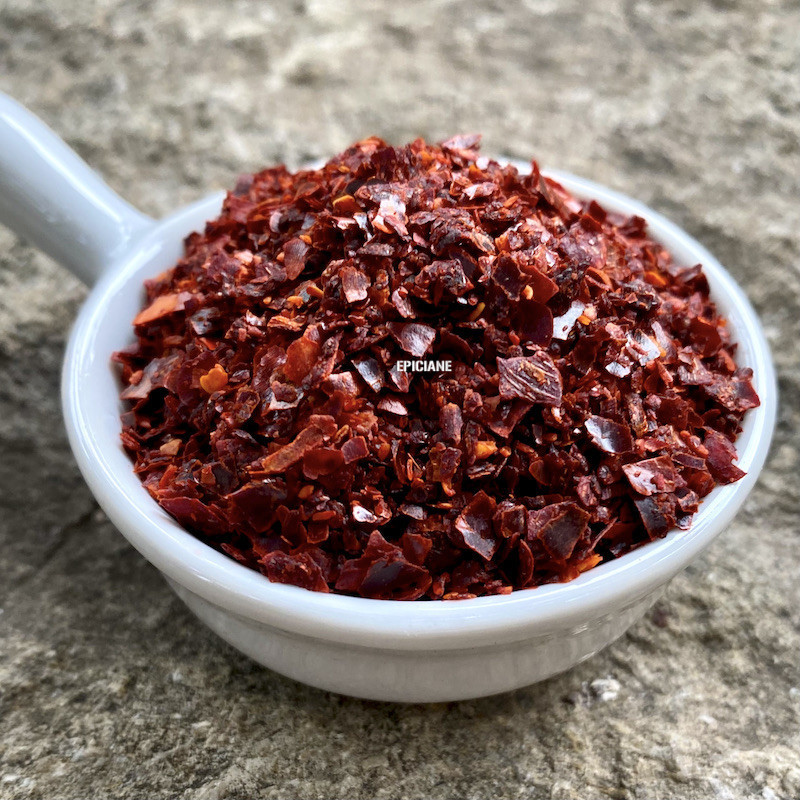
Reference: 810220


Its taste is similar to that of bell pepper (it belongs to the same family), with a hint of tomato.
It is widely used in Spain with fish, vegetables, and meats, as well as in paellas. It is often paired with dishes containing tomato as their flavors complement each other perfectly.
 Delivery
Delivery
Mondial Relay
 Returns
Returns
See conditions
 Payments
Payments
100% secure
Livré en sachet refermable
Uses in Cooking:
The taste of Niora is very mild, as gentle as our traditional bell pepper, but with a slightly different flavor, closer to the taste of sun-dried tomatoes and paprika with a subtle smoky undertone.
Niora is traditionally cooked with fish, such as cod with tomato, but also with vegetables like in ratatouille, with meats like rabbit, with eggs, fish, and white meats, most often accompanied by tomatoes.
It is widely used in Spanish cuisine, though not exclusively, especially paired with tomatoes, with which its flavor harmonizes beautifully. It is notably found in paellas, where it is mixed with tomatoes and rice, and whole Nioras are often kept as decoration on top.
Who am I?
Origin: Spain
Scientific name: Capsicum annuum
Niora is a variety of pepper originating from South America, like all its cousins, peppers and chilis. Initially, Niora appears as a small round fruit, somewhat resembling a tomato.
The term "hojilla" Niora comes from the Spanish word meaning "leaf"; thus, it refers to Niora in "leaves" or "flakes" or "crushed," as you prefer.
It is an annual plant from the Solanaceae family, with fruits harvested from September to November. Some fruits are kept whole, dried, and used as decorations, notably in paellas, while the rest are crushed to obtain the product I offer.
Capsaicin is the active component of the plant. Like all peppers and chilis, it also contains vitamins A and C.
A Bit of History:
Niora was discovered by Christopher Columbus, who brought it back from South America along with all its cousins, commonly called peppers or chilis, when he discovered the continent. This large family has since spread worldwide and has become essential to the cuisine of all countries.
Data sheet
 Yves L.
Yves L.
Bon produit
 Anne Marie P.
Anne Marie P.
Complement parfait des sauces
 Jean-Philippe L.
Jean-Philippe L.
pas encore utilisé

 Yves L.
Yves L.
Bon produit
 Anne Marie P.
Anne Marie P.
Complement parfait des sauces
 Jean-Philippe L.
Jean-Philippe L.
pas encore utilisé

Reference: 810220
Reference: 508212501
Reference: italien
Reference: gingembreM
Reference: 208037910
Reference: fenouilE
Reference: 3N7137901
Reference: 30803202
Reference: 20721302
Reference: 20701706
Reference: anisvertM
Reference: 208022801
Reference: Harissa
Reference: 1N6987004
Reference: 3N7201902
Reference: coriandreE
Reference: 20703402
Reference: 6L5609803
Reference: 3N7153402

Its taste is similar to that of bell pepper (it belongs to the same family), with a hint of tomato.
It is widely used in Spain with fish, vegetables, and meats, as well as in paellas. It is often paired with dishes containing tomato as their flavors complement each other perfectly.